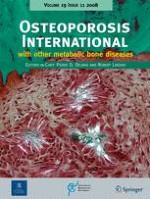Published in:

01-11-2008 | Original Article
The BPAQ: a bone-specific physical activity assessment instrument
Authors:
B. K. Weeks, B. R. Beck
Published in:
Osteoporosis International
|
Issue 11/2008
Login to get access
Abstract
Summary
A newly developed bone-specific physical activity questionnaire (BPAQ) was compared with other common measures of physical activity for its ability to predict parameters of bone strength in healthy, young adults. The BPAQ predicted indices of bone strength at clinically relevant sites in both men and women, while other measures did not.
Introduction
Only certain types of physical activity (PA) are notably osteogenic. Most methods to quantify levels of PA fail to account for bone relevant loading. Our aim was to examine the ability of several methods of PA assessment and a new bone-specific measure to predict parameters of bone strength in healthy adults.
Methods
We recruited 40 men and women (mean age 24.5). Subjects completed the modifiable activity questionnaire, Bouchard 3-day activity record, a recently published bone loading history questionnaire (BLHQ), and wore a pedometer for 14 days. We also administered our bone-specific physical activity questionnaire (BPAQ). Calcaneal broadband ultrasound attenuation (BUA) (QUS-2, Quidel) and densitometric measures (XR-36, Norland) were examined. Multiple regression and correlation analyses were performed on the data.
Results
The current activity component of BPAQ was a significant predictor of variance in femoral neck bone mineral density (BMD), lumbar spine BMD, and whole body BMD (R2 = 0.36–0.68, p < 0.01) for men, while the past activity component of BPAQ predicted calcaneal BUA (R2 = 0.48, p = 0.001) for women.
Conclusions
The BPAQ predicted indices of bone strength at skeletal sites at risk of osteoporotic fracture while other PA measurement tools did not.